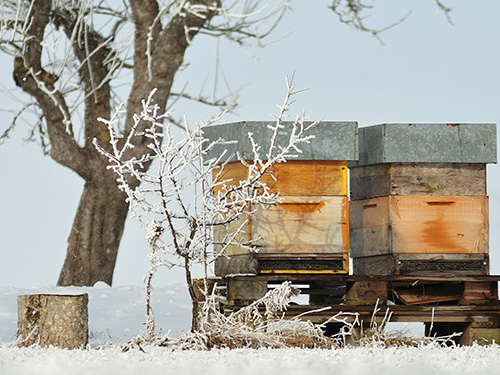Supporting Your Hive Through the Cold Months
Jan 06, 2025

As the seasons change and temperatures drop, you might wonder how honeybees manage to survive the winter months. Unlike many insects that hibernate, honeybees remain active year-round, relying on their intricate social structure and careful preparation to make it through to spring.
Winter is a crucial time for beekeepers to support their hives. Here's a guide to understanding what honeybees do during the winter and how you can help them thrive.
What Happens Inside the Hive in Winter?
When temperatures dip below 55°F, honeybees retreat to their hive and form a cluster around their queen. Their primary goal during this period is to protect her, as she is essential for the hive’s survival and future growth. The colder it gets, the tighter this cluster becomes.
To generate warmth, bees shiver their flight muscles, which can increase the internal hive temperature to around 96°F near the queen. Bees rotate through the cluster, taking turns warming up in the center before moving to the outer layers.
How to Support Your Bees During Winter:
At Co-op, we understand the unique challenges of winter beekeeping and are here to help. From feeding tools to hive insulation products and pest prevention solutions, many of our locations carry everything you need to support your bees through the cold months. Visit your local Co-op today for expert advice and supplies.
Find the nearest Co-op location here. For more seasonal farm tips, check out the latest issue of The Cooperator.
Winter is a crucial time for beekeepers to support their hives. Here's a guide to understanding what honeybees do during the winter and how you can help them thrive.
What Happens Inside the Hive in Winter?
When temperatures dip below 55°F, honeybees retreat to their hive and form a cluster around their queen. Their primary goal during this period is to protect her, as she is essential for the hive’s survival and future growth. The colder it gets, the tighter this cluster becomes.
To generate warmth, bees shiver their flight muscles, which can increase the internal hive temperature to around 96°F near the queen. Bees rotate through the cluster, taking turns warming up in the center before moving to the outer layers.
How to Support Your Bees During Winter:
- Leave Enough Honey:
Bees rely on the honey they’ve stored during the active seasons for energy throughout the winter. A healthy hive typically needs around 30–50 pounds of honey to make it through. Harvest carefully in the fall to ensure they have enough reserves. - Monitor Hive Ventilation:
While it’s important to keep the hive warm, good ventilation is also critical. Excess humidity can lead to condensation, which may drip onto bees and chill them. Use a moisture board or upper entrance to help regulate airflow and prevent mold. - Avoid Frequent Hive Checks:
Opening the hive when it’s below 40°F allows warm air to escape, potentially putting the bees at risk. Instead, gently tap the outside of the hive and listen for buzzing to confirm the bees are active. - Insulate the Hive:
In extremely cold climates, consider insulating the hive with foam boards or wrapping it with breathable materials. Hay bales can also provide windbreaks, but watch for rodents seeking shelter. Elevating the hive and using mouse guards will help deter these unwanted guests. - Prepare Emergency Food Supplies:
Late winter is one of the riskiest times for honeybees. As they start foraging on warmer days, there’s often little nectar or pollen available, leading to starvation. Providing fondant, sugar bricks, or syrup can keep them sustained until spring flowers bloom.
At Co-op, we understand the unique challenges of winter beekeeping and are here to help. From feeding tools to hive insulation products and pest prevention solutions, many of our locations carry everything you need to support your bees through the cold months. Visit your local Co-op today for expert advice and supplies.
Find the nearest Co-op location here. For more seasonal farm tips, check out the latest issue of The Cooperator.